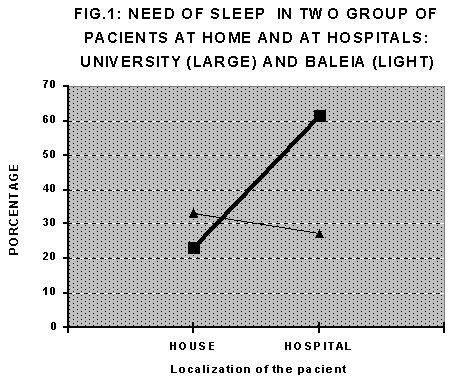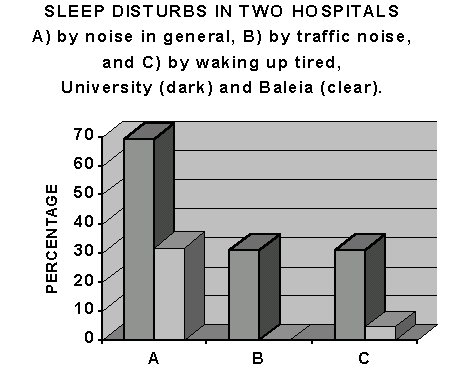
F Pimentel-Souza, JC Carvalho, PAS Alvares, CJS Rodrigues and AL Siqueira
SUMMARY: Patients of two hospitals in Belo Horizonte (BH) were questionned on the eve of discharge to evaluate the sleep conditions related to noise. Patients had a worse perception of sleep at University Hospital, whose internal nocturnal Leq=53.7 dB(A) was greater than the one at Baleia Hospital, Leq=45.5 dB(A). Noise was the only sleep-disturbing factor to be statistically significant. Cortisol levels were not statistically different.
The quality of sleep is frequently impaired by the excess of noise of the modern society, and in overpopulated cities it needs to be better characterized, especially for patients in hospitals, because it is assumed to be important for patients recovery (1-7).
The external diurnal mean level, Leq=69.5 dB(A), in City of Belo Horizonte, is considered to be excessive (8). To compare the patients perception of their own sleep, a questionnaire was applied during 1994 to male patients in two public hospitals: Baleia, a quiet one, and University, a noisy one. The 35 patients selected did not present any disease that would be expected to directly affect the sleep and were not users of somniferous or sedatives drugs. Only patients on the eve of discharge were evaluated, concerning the previous night sleep. The patients were between 17 and 60 years old, averaging 35.6. The reliability were evaluated by K index, the comparison of rates by the Fisher's exact test and the Binomial test (9).
The three modalities of insomnia are elevated in both hospitals. Nocturnal awakening affected 91.4% of the patients, with mean of 2.6 times, surprisingly uniformely ranged from 17 up 60 years old, against about 1 in three middle size cities in Europe. Difficulties inducing sleep, 51.4% of patients, is much greater than the 32% in Sao Paulo City, one of the greatest rates in the world. In Europe this values are about 7,5%. Early morning awakening, 31.4% of patients, per night, against 5,5% in Europe (10,11). Medical care disturbed the sleep of 43.0% of the patients, organic diseases for 29.0%, psychological problems for 17.0% and parasomnias for 28.0% per night. However, only in terms of environmental conditions, 66.0% of the patients reported disturbs, in which 45.7% were affect by noise, 31.4% were affected by illumination, 22.9% were affected by temperature, 20.0% were affected by the presence or attention to another people and 11% were affected by lack of adaptation to the hospital setting, per night. These percentages are considerably greater than those of citizens of Sao Paulo City, which are 14% due to external factors and 9.5% due only to noise (10).
To assess the noise influence, it was studied separately the two hospitals. At University 66.9% of patients desired a longer sleep duration on the last night and this was statistically different from 27.3% for patients at Baleia (Figure 1). There was no statistical difference at home. The difference between hospital and home (25%) was statistically significant at University and not at Baleia, respectively 27.3% and 31.5%. The slightly better sleep rate for last hospital than at home indicates possibility of controlling sleep quality during hospitalization.
For all 24 questions the results indicated better sleep at Baleia patients, except "sleep perturbation due to temperature". This item and "sleep pertubation due to illumination" are the only ones in which the internal hospital noise could not be one of the intervening cause. However, only in three items the comparison of rates between the two groups were statistically different (9) (Figures 1,2). At University 30.8% of the patients reported having tired on awakening and was significantly greater than the 4.6% of the patients, at Baleia. At University the percentage of patients, who woke up tired, is greater than for the dwellers of British airports’ neighbourhoods, where sound levels are considered disturbing (12).


For all other evaluated possible causes for sleeping perturbation there was no difference between the two hospitals, except noise. At University (69.2%) this factor was significantly greater than at Baleia (31.8%). At home the difference was not significant (Figure 2). At home the majority of patients of both hospitals, who are poor and usually reside in the outskirks of city, seem already affected by sleep disturb induced by noise. Since the noise level increase toward downtown, the sleep pertubation by noise must still be higher, reaching those levels shown at University and corroborating the fact that BH is considered to be a noisy city (8). The rates of sleeping disorder induced by noise at University were greater than the one found in citizens of Oklahoma, USA, and in France (4), and they correspond
to those found between Zaragoza’s citizens, Spain, where noise in the first cause of claims of sleep perturbation (13). Particularly, 30.8% at University’s patients pointed out traffic noise as the significantly greater sleep-disturbing factor than 0% at Baleia’s (Figure 2). There was no difference between the two hospitals groups concerning sleep perturbation due to medical care, organic disease or psychological perturbation at the hospital or at home. The rates of diseases sleeping disorder seem to indicate that the patients are in the way of recovering at hospitals. It turns out that a better sleep and a smaller noise level corroborate to immunological recovery (2,7), whose better scores were found at Baleia.
Sleep perturbations due to noise have been reported in subjective (6,10,12) and objective studies (3,14,15,16), found a decreasing III, IV and V stage's lengths of deep sleep in EEG. Sleep quality was reduced since 45 dB(A), which is the maximum value recommended at residences and at hospitals in Brazil (1,3,17). The mean levels of noise recommended by WHO and the Brazilian Agency are of Leq=35 and 40 dB(A) respectively (17,18). The quietest hospital, Baleia, with nocturnal internal Leq=45.5 dB(A) and Lmax=50.6 dB(A), monitored each minute during 500 minutes, is not at satisfactory standards at night. However, the overall conditions observed for University Hospital patients sleep, with nocturnal internal Leq=53.7 dB(A) and Lmax=59.1 dB(A), is worse due to its noisy environment. The nocturnal sound Leq of the two hospitals were significantly different (t-Student test, P<0.05), but urinary cortisol were not statistically different, indicating that sound stress has not attained exhausting levels.
References: 1.A Chapon et al. Inst Recherche et Transports, France, (1972). 2.RW Cantrell. The Laryngoscope, suppl 1, LXXXIV(10/2),1-55, (1974). 3.MG Terzano et al. Eletroenceph. clin. Neurophysiol., 76, 29-38, (1990). 4.J Mouret J and M Vallet. Min Santé et Action Hum, France, (1992). 5.M Soyer and JL Pichon. Proc 6th Int Cong, vol 2:621-624, France, (1993). 6.Ohrstrom E. Proc 6th Int Cong, vol 3:331-338, France, (1993). 7.K Altena and DGM Beersma. Proc 6th Int Cong, vol 2:575-578, France, (1993). 8.F Pimentel-Souza and PAS Alvares. Proc 6th Int Cong, vol 2:441-444, (1993) 9.F Pimentel-Souza et al. Braz J Med Biol Res, 29 (1996, in press). 10.S Braz. Doctoral thesis, Escola Paulista de Medicina, São Paulo, (1988). 11.C Janson et al. Sleep, 18(7):589-597, (1995). 12.J Ollerhead and I Diamond. Proc 6th Int Cong, vol 3:373-376, France, (1993). 13.PAS Sanches and JC Celme. Proc 6th Int Cong, vol.2, 323-326, (1993). 14.J Friedman and G Globus. NASA, USA, (1974). 15.M Vallet et al. Inst Recherche et Transports, France, (1975) 16.M Vallet et al. Inst Recherche et Transports, France, (1977). 17.ABNT. NB-95. ABNT, Brazil, (1966). 18.WHO. Noise. WHO, Geneva, (1980).